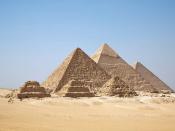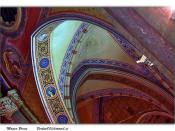All throughout history art has thrived in most prospering civilizations. These works of art are very often expressed the political, social, and economic conditions of the time period in which they were created. The Egyptian pyramids and the Gothic Cathedrals are the epitome of works of art that express political, social, and economic conditions.
The Egyptian pyramids date back to Ancient Egypt from 3200 B.C- 500 B.C. The Ancient Egyptians created these pyramids for many reasons. They reflected many aspects of their lives, including economically, socially, and politically. These pyramids were tombs for the pharaohs, which were associated with all aspects of the Egyptians lives. The pharaohs were the heads of the political system; they were also looked up to as religious figures. They were seen as gods. They were obviously at the top of the social class, as well. These huge monuments and pyramids show just how much the people worshipped these pharaohs.
The building of these pyramids also show that the Egyptians were doing well economically. If they weren't doing well economically, then they wouldn't have all that time to build such vast pyramids. They also wouldn't have all those people to do that labor of building these huge pyramids. This is one work of art that has survived many years in the desert and still expresses many aspects of its time period. The pyramids do not stand alone in being an old work of art that shows many different aspects from the time period in which it was built.
The Gothic cathedrals also stand tall today in places in Europe like Paris and Italy. These cathedrals were built during the medieval times. The Notre Dame cathedral is just one example of these cathedrals that had high pointed arches, flying buttresses, spires, and high vaulted ceilings. These cathedrals...


